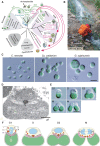The Unicellular Red Alga Cyanidioschyzon merolae-The Simplest Model of a Photosynthetic Eukaryote
- PMID: 33836072
- PMCID: PMC8504449
- DOI: 10.1093/pcp/pcab052
The Unicellular Red Alga Cyanidioschyzon merolae-The Simplest Model of a Photosynthetic Eukaryote
Abstract
Several species of unicellular eukaryotic algae exhibit relatively simple genomic and cellular architecture. Laboratory cultures of these algae grow faster than plants and often provide homogeneous cellular populations exposed to an almost equal environment. These characteristics are ideal for conducting experiments at the cellular and subcellular levels. Many microalgal lineages have recently become genetically tractable, which have started to evoke new streams of studies. Among such algae, the unicellular red alga Cyanidioschyzon merolae is the simplest organism; it possesses the minimum number of membranous organelles, only 4,775 protein-coding genes in the nucleus, and its cell cycle progression can be highly synchronized with the diel cycle. These properties facilitate diverse omics analyses of cellular proliferation and structural analyses of the intracellular relationship among organelles. C. merolae cells lack a rigid cell wall and are thus relatively easily disrupted, facilitating biochemical analyses. Multiple chromosomal loci can be edited by highly efficient homologous recombination. The procedures for the inducible/repressive expression of a transgene or an endogenous gene in the nucleus and for chloroplast genome modification have also been developed. Here, we summarize the features and experimental techniques of C. merolae and provide examples of studies using this alga. From these studies, it is clear that C. merolae-either alone or in comparative and combinatory studies with other photosynthetic organisms-can provide significant insights into the biology of photosynthetic eukaryotes.
Keywords: Cyanidioschyzon merolae; Cyanidiales; Photosynthetic eukaryotes; Red algae.
© The Author(s) 2021. Published by Oxford University Press on behalf of Japanese Society of Plant Physiologists.
Figures



Similar articles
-
Day/Night Separation of Oxygenic Energy Metabolism and Nuclear DNA Replication in the Unicellular Red Alga Cyanidioschyzon merolae.mBio. 2019 Jul 2;10(4):e00833-19. doi: 10.1128/mBio.00833-19. mBio. 2019. PMID: 31266864 Free PMC article.
-
A cotransformation system of the unicellular red alga Cyanidioschyzon merolae with blasticidin S deaminase and chloramphenicol acetyltransferase selectable markers.BMC Plant Biol. 2021 Dec 4;21(1):573. doi: 10.1186/s12870-021-03365-z. BMC Plant Biol. 2021. PMID: 34863100 Free PMC article.
-
Uncommon properties of lipid biosynthesis of isolated plastids in the unicellular red alga Cyanidioschyzon merolae.FEBS Open Bio. 2018 Dec 4;9(1):114-128. doi: 10.1002/2211-5463.12551. eCollection 2019 Jan. FEBS Open Bio. 2018. PMID: 30652079 Free PMC article.
-
Genome analysis and its significance in four unicellular algae, Cyanidioschyzon [corrected] merolae, Ostreococcus tauri, Chlamydomonas reinhardtii, and Thalassiosira pseudonana.J Plant Res. 2008 Jan;121(1):3-17. doi: 10.1007/s10265-007-0133-9. Epub 2007 Dec 12. J Plant Res. 2008. PMID: 18074102 Review.
-
Lipid metabolism and potentials of biofuel and high added-value oil production in red algae.World J Microbiol Biotechnol. 2017 Apr;33(4):74. doi: 10.1007/s11274-017-2236-3. Epub 2017 Mar 16. World J Microbiol Biotechnol. 2017. PMID: 28303457 Review.
Cited by
-
Deciphering the function and evolution of the target of rapamycin signaling pathway in microalgae.J Exp Bot. 2022 Nov 15;73(20):6993-7005. doi: 10.1093/jxb/erac264. J Exp Bot. 2022. PMID: 35710309 Free PMC article.
-
Cultivation of the polyextremophile Cyanidioschyzon merolae 10D during summer conditions on the coast of the Red Sea and its adaptation to hypersaline sea water.Front Microbiol. 2023 Apr 20;14:1157151. doi: 10.3389/fmicb.2023.1157151. eCollection 2023. Front Microbiol. 2023. PMID: 37152750 Free PMC article.
-
Increasing thermostability of the key photorespiratory enzyme glycerate 3-kinase by structure-based recombination.Plant Biotechnol J. 2025 Feb;23(2):454-466. doi: 10.1111/pbi.14508. Epub 2024 Nov 17. Plant Biotechnol J. 2025. PMID: 39550762 Free PMC article.
-
Life cycle and functional genomics of the unicellular red alga Galdieria for elucidating algal and plant evolution and industrial use.Proc Natl Acad Sci U S A. 2022 Oct 11;119(41):e2210665119. doi: 10.1073/pnas.2210665119. Epub 2022 Oct 4. Proc Natl Acad Sci U S A. 2022. PMID: 36194630 Free PMC article.
-
Metabolic modeling suggested noncanonical algal carbon concentrating mechanism in Cyanidioschyzon merolae.Plant Physiol. 2025 Feb 7;197(2):kiaf019. doi: 10.1093/plphys/kiaf019. Plant Physiol. 2025. PMID: 39820711 Free PMC article. No abstract available.
References
-
- Albertano P., Ciniglia C., Pinto G., Pollio A. (2000) The taxonomic position of Cyanidium, Cyanidioschyzon and Galdieria: an update. Hydrobiologia 433: 137–143.
-
- Antoshvili M., Caspy I., Hippler M., Nelson N. (2019) Structure and function of photosystem I in Cyanidioschyzon merolae. Photosynth. Res. 139: 499–508. - PubMed
Publication types
MeSH terms
Grants and funding
LinkOut - more resources
Full Text Sources
Other Literature Sources
Research Materials

